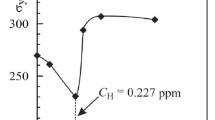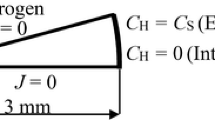Abstract
Herein, the interaction between hydrogen, microstructure, and mechanical properties in low-alloy high-strength marine steel was elucidated via microstructural characterization, internal friction analysis, hydrogen diffusion, and hydrogen-embrittlement sensitivity evaluation. Results indicated that the bainite structure of hot-rolled steel transformed into a coarse ferrite–pearlite structure after normalizing, and the hydrogen trap density decreased with decreasing grain boundary and dislocation densities. Therefore, the effective diffusion coefficient of hydrogen in the normalized steel plates increased with decreasing hydrogen permeation time. Owing to the coarsening of the microstructure, the normalized steel plates exhibited higher sensitivity to hydrogen embrittlement. The diffusion of a large amount of hydrogen into the steel considerably deteriorated its plasticity, resulting in a transition of its fracture mode from microvoid coalescence fracture to cleavage fracture. The internal friction behavior indicated that hydrogen in the microstructure generated a hydrogen-induced Snoek peak, as well as reduced the activation energy of Snoek–Kê–Köster and Kê peaks. Finally, the internal friction spectra revealed that the interaction between hydrogen and point defects, dislocations, grain boundaries, and precipitates was sequentially enhanced due to the increase in activation energy.








Similar content being viewed by others
References
M.B. Djukic, V. Sijacki Zeravcic, G.M. Bakic, A. Sedmak and B. Rajicic, Hydrogen Damage of Steels: A Case Study and Hydrogen Embrittlement Model, Eng. Fail. Anal., 2015, 58, p 485–498.
Q. Deng, W. Zhao, W. Jiang, T. Zhang, T. Li and Y. Zhao, Hydrogen Embrittlement Susceptibility and Safety Control of Reheated CGHAZ in X80 Welded Pipeline, J. Mater. Eng. Perform., 2018, 27(4), p 1654–1663.
V. Arniella, A. Zafra, G. Álvarez, J. Belzunce and C. Rodríguez, Comparative Study of Embrittlement of Quenched and Tempered Steels in Hydrogen Environments, Int. J. Hydrog Energ., 2022, 47(38), p 17056–17068.
J. Venezuela, T. Hill, Q. Zhou, H. Li, Z. Shi, F. Dong, R. Knibbe, M. Zhang, M.S. Dargusch and A. Atrens, Hydrogen-Induced Fast Fracture in Notched 1500 and 1700 MPa Class Automotive Martensitic Advanced High-Strength Steel, Corros. Sci., 2021, 188, p 109550.
N. **ao, W. Hui, Y. Zhang and X. Zhao, Hydrogen Embrittlement Behavior of a Vacuum-Carburized Gear Steel, Acta Metall. Sin., 2021, 57, p 977–988.
L.W. Tsay, H.L. Lu and C. Chen, The Effect of Grain Size and Aging on Hydrogen Embrittlement of a Maraging Steel, Corros. Sci., 2008, 50, p 2506–2511.
S. Lynch, Hydrogen Embrittlement Phenomena and Mechanisms, Corros. Rev., 2012, 30, p 105–123.
M. Koyama, E. Akiyama, Y.-K. Lee, D. Raabe and K. Tsuzaki, Overview of Hydrogen Embrittlement in High-Mn Steels, Int. J. Hydrog. Energ., 2017, 42(17), p 12706–12723.
H. Ma, L. Sun, H. Luo and X. Li, Hydrogen Embrittlement of High-Strength Marine Steel as a Weld Joint in Artificial Seawater Under Cathodic Polarization, Eng. Fail. Anal., 2022, 134, p 106044.
A. Świerczyńska, D. Fydrych, M. Landowski, G. Rogalski and J. Łabanowski, Hydrogen Embrittlement of X2CrNiMoCuN25-6-3 Super Duplex Stainless Steel Welded Joints Under Cathodic Protection, Constr. Build. Mater., 2020, 238, p 117697.
Z. Wang, Q. Lu, Z.H. Cao, H. Chen, M.X. Huang and J.F. Wang, Review on Hydrogen Embrittlement of Press-Hardened Steels for Automotive Applications, Acta Metall. Sin. Engl. Lett., 2022 https://doi.org/10.1007/s40195-022-01408-4
M. Pinson, L. Claeys, H. Springer, V. Bliznuk, T. Depover and K. Verbeken, Investigation of the Effect of Carbon on the Reversible Hydrogen Trap** Behavior in Lab-Cast Martensitic Fe–C Steels, Mater. Charact., 2022, 184, p 111671.
W. Hui, H. Zhang, Y. Zhang, X. Zhao and C. Shao, Effect of Nickel on Hydrogen Embrittlement Behavior of Medium-Carbon High Strength Steels, Mater. Sci. Eng. A, 2016, 674, p 615–625.
P. Xu, C. Li, M. Wei Li, W.L. Zhu and K. Zhang, Effect of Microstructure on Hydrogen Embrittlement Susceptibility in Quenching-Partitioning-Tempering Steel, Mater. Sci. Eng. A, 2022, 831, p 142046.
K.S. Ghosh and D.K. Mondal, Effect of Grain Size on Mechanical Electrochemical and Hydrogen Embrittlement Behaviour of a Micro-Alloy Steel, Mater. Sci. Eng. A, 2013, 559, p 693–705.
M.A. Liu, P.E.J. Rivera-Díaz-del-Castillo, J.I. Barraza-Fierro, H. Castaneda and A. Srivastava, Microstructural Influence on Hydrogen Permeation and Trap** in Steels, Mater. Des., 2019, 167, p 107605.
D. Zhang, X. Gao, Y. Du, L. Du, H. Wang, Z. Liu and G. Su, Effect of Microstructure Refinement on Hydrogen-Induced Damage Behavior of Low Alloy High Strength Steel for Flexible Riser, Mater. Sci. Eng. A, 2019, 765, p 138278.
R. Shi, Z. Wang, L. Qiao and X. Pang, Effect of In-Situ Nanoparticles on the Mechanical Properties and Hydrogen Embrittlement of High-Strength Steel, Int. J. Miner. Metall. Mater., 2021, 28(4), p 644–656.
S. Zhang, S. Liu, J. Wan and W. Liu, Effect of Nb–Ti Multi-microalloying on the Hydrogen Trap** Efficiency and Hydrogen Embrittlement Susceptibility of Hot-Stamped Boron Steel, Mater. Sci. Eng. A, 2020, 772, p 138788.
J. Moon, J. Choi, S.-K. Han, S. Huh, S.-J. Kim, C.-H. Lee and T.-H. Lee, Influence of Precipitation Behavior on Mechanical Properties and Hydrogen Induced Cracking During Tempering of Hot-Rolled API Steel for Tubing, Mater. Sci. Eng. A, 2016, 652, p 120–126.
Y.-S. Chen, D. Haley, S.S.A. Gerstl, A.J. London, F. Sweeney, R.A. Wepf, W.M. Rainforth, P.A.J. Bagot and M.P. Moody, Direct Observation of Individual Hydrogen Atoms at Trap** Sites in a Ferritic Steel, Science, 2017, 355, p 1196–1199.
L. Shi, Z. Yan, Y. Liu, C. Zhang, Z. Qiao, B. Ning and H. Li, Improved Toughness and Ductility in Ferrite/Acicular Ferrite Dual-Phase Steel Through Intercritical Heat Treatment, Mater. Sci. Eng. A, 2014, 590, p 7–15.
M. Masoumi, L.P.M. Santos, I.N. Bastos, S.S.M. Tavares, M.J.G. da Silva and H.F.G. de Abreu, Texture and Grain Boundary Study in High Strength Fe–18Ni–Co Steel Related to Hydrogen Embrittlement, Mater. Des., 2016, 91, p 90–97.
P. Gong, J. Nutter, P.E.J. Rivera-Diaz-Del-Castillo and W.M. Rainforth, Hydrogen Embrittlement Through the Formation of Low-Energy Dislocation Nanostructures in Nanoprecipitation-Strengthened Steels, Sci. Adv., 2020, 6, p eabb6152.
P. Gong, A. Turk, J. Nutter, F. Yu, B. Wynne, P. Rivera-Diaz-del-Castillo and W.M. Rainforth, Hydrogen Embrittlement Mechanisms in Advanced High Strength Steel, Acta Mater., 2022, 223, p 117488.
R. Silverstein, D. Eliezer and E. Tal-Gutelmacher, Hydrogen Trap** in Alloys Studied by Thermal Desorption Spectrometry, J. Alloy. Compd., 2018, 747, p 511–522.
A. Tehranchi, X. Zhou and W.A. Curtin, A Decohesion Pathway for Hydrogen Embrittlement in Nickel: Mechanism and Quantitative Prediction, Acta Mater., 2020, 185, p 98–109.
J. Venezuela, Q. Liu, M. Zhang, Q. Zhou and A. Atrens, A Review of Hydrogen Embrittlement of Martensitic Advanced High-Strength Steels, Corros. Rev., 2016, 34(3), p 153–186.
D. Zhang, W. Li, X. Gao, L. Fu, J. Guo, J. Zhang, Q. Pang and Z. Xu, Effect of Cold Deformation Before Heat Treatment on the Hydrogen Embrittlement Sensitivity of High-Strength Steel for Marine Risers, Mater. Sci. Eng. A, 2022, 845, p 143220.
H. Zhang, J. Hou, D. Zhang, W. Li, J. Xu, Q. Pang, Q. Zhu and J. Zhang, Effect of Quenching, Lamellarizing, and Tempering on Reversed Austenite and Cryogenic Toughness of 9Ni Steels, J. Mater. Eng. Perform., 2023 https://doi.org/10.1007/s11665-023-08129-4
D. Zhang, C. Cui, W. Li and J. Xu, Hydrogen Diffusion and Hydrogen Embrittlement Failure Behavior of AH36 Marine Steel Subjected to High Heat Input Welding, Steel Res. Int., 2023, 94, p 2200539.
J. Hu, L.-X. Du, W. Xu, J.-H. Zhai, Y. Dong, Y.-J. Liu and R.D.K. Misra, Ensuring Combination of Strength, Ductility and Toughness in Medium-Manganese Steel Through Optimization of Nano-scale Metastable Austenite, Mater. Charact., 2018, 136, p 20–28.
J. Hu, L.-X. Du, Y. Dong, Q.-W. Meng and R.D.K. Misra, Effect of Ti Variation on Microstructure Evolution and Mechanical Properties of Low Carbon Medium Mn Heavy Plate Steel, Mater. Charact., 2019, 152, p 21–35.
L. Vandewalle, M.J. Konstantinović, K. Verbeken and T. Depover, A Combined Thermal Desorption Spectroscopy and Internal Friction Study on the Interaction of Hydrogen with Microstructural Defects and the Influence of Carbon Distribution, Acta Mater., 2022, 241, p 118374.
W. Li, H. Zhang, H. Fu, J. Zhang and X. Qi, Internal Friction Study of Mechanism of Bake-Hardening on Low Carbon Steel, Acta Metall. Sin., 2015, 51, p 385–392.
M. Sun, W. Jiang, X. Liu, T. Chen, X. Wang and Q. Fang, A Comparative Study on the Grain Boundary Internal Friction Peak of Pure Iron, Mater. Lett., 2021, 305, p 130814.
X.Y. Cheng, H. Li and X.B. Cheng, Carbides and Possible Hydrogen Irreversible Trap** Sites in Ultrahigh Strength Round Steel, Micron, 2017, 103, p 22–28.
W. Chen, W. Zhao, P. Gao, F. Li, S. Kuang, Y. Zou and Z. Zhao, Interaction Between Dislocations, Precipitates and Hydrogen Atoms in a 2000 MPa Grade Hot-Stamped Steel, J. Mater. Res. Technol., 2022, 18, p 4353–4366.
N. Yu and J.W. Ji, The Internal Friction of Deformed Fe-Nb-C Alloys in the Range from Room Temperature to 180 °C, Acta Metall. Sin., 2002, 38(3), p 230–234.
X. Yuan, W. Li, Q. Pang, C. Zhang and G. Lu, Study on the Performance and Strain Aging Behavior of Solid-Solution State Low-Carbon Steel, Mater. Sci. Eng. A, 2018, 726, p 282–287.
Acknowledgments
This research was financially supported by the National Natural Science Foundation of China (Grant Nos. 52074152, 52204346), Joint Foundation of University of Science and Technology Liaoning and State Key Laboratory of metal materials for marine equipment and application (Grant No. HGSKL-USTLN(2022)03).
Author information
Authors and Affiliations
Corresponding authors
Additional information
Publisher's Note
Springer Nature remains neutral with regard to jurisdictional claims in published maps and institutional affiliations.
Rights and permissions
Springer Nature or its licensor (e.g. a society or other partner) holds exclusive rights to this article under a publishing agreement with the author(s) or other rightsholder(s); author self-archiving of the accepted manuscript version of this article is solely governed by the terms of such publishing agreement and applicable law.
About this article
Cite this article
Zhang, D., Li, B., Fu, L. et al. Mechanism of the Interaction Between Hydrogen, Microstructure, and Mechanical Properties in Low-Alloy High-Strength Marine Steel. J. of Materi Eng and Perform (2023). https://doi.org/10.1007/s11665-023-08637-3
Received:
Revised:
Accepted:
Published:
DOI: https://doi.org/10.1007/s11665-023-08637-3




